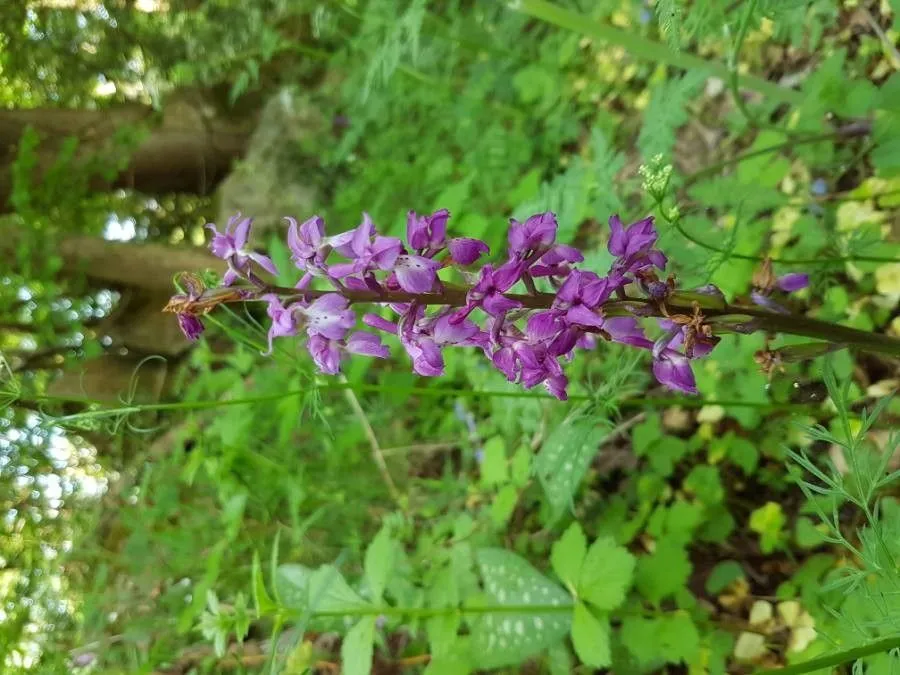
Author: (L.) L.
Bibliography: Fl. Suec., ed. 2: 310 (1755)
Year: 1755
Status: accepted
Rank: species
Genus: Orchis
Vegetable: Unknown
Observations: Macaronesia, N. & C. Europe to Iran
The Early Purple Orchid, scientifically known as Orchis mascula, is a captivating member of the Orchidaceae family. This exquisite plant was first documented in the second edition of “Flora Suecica” in 1755, under the authorship of the esteemed botanist Carl Linnaeus, often denoted by the abbreviation (L.) L.
Thriving across a diverse geographical range, the Early Purple Orchid can be found in regions from Macaronesia, an archipelago in the North Atlantic Ocean, through Northern and Central Europe, extending its presence as far as Iran. Such extensive distribution highlights its adaptability to various climates and habitats, from woodland clearings and meadows to mountainsides and marshes.
The Early Purple Orchid is renowned for its vivid, striking flowers that typically bloom in early spring, signifying the onset of the warmer seasons. The flowers exhibit a breathtaking palette of purples, each blossom arranged intricately on a tall spike, making them highly attractive to both humans and pollinators like bees and butterflies. The plant’s leaves, often adorned with dark spots, contribute to its distinctive appearance, adding to its ethereal beauty.
Ecologically, Orchis mascula plays a vital role in maintaining biodiversity within its habitats. As an ancient species, it has evolved complex relationships with specific pollinators, ensuring the propagation of both the plant and its pollinating partners. This mutualistic relationship underscores the importance of conserving natural habitats that host such intricate biological interactions.
In addition to its ecological importance, the Early Purple Orchid has held cultural significance in various regions throughout history. Folklore and traditional uses have often attributed medicinal properties to the plant, though such uses require careful consideration due to potential toxicity.
In conclusion, Orchis mascula is not just a botanical gem for plant enthusiasts but also a crucial component of the ecosystems it inhabits. Its presence is a testament to the incredible diversity and resilience of the natural world, and it continues to inspire admiration and efforts toward conservation.
Deu: maennliche orchis, männliches knabenkraut i.w.s., stattliches knabenkraut
Swe: sankt pers nycklar, miehenkämmekkä, sankt pers nyckel, sankt pers nyckelblomster
Nor: st. hans nøkkler, nakenmann
Dan: tyndakset gøgeurt
Eng: early purple orchid, salep, early-purple orchid
Nld: mannetjesorchis
Fin: miehenkämmekkä
Lav: viru dzeguzpuke
Nno: vårmarihand
Nob: vårmarihand
Sme: biehtárgeapman
Cym: caill y ci, hosanau’r gog, tegeirian borffor, tegeirian coch, tegeirian coch y gwanwyn, tegeirian glasgoch y gwanwyn, tegeirian y gwanwyn
En: Early purple orchid, Salep, Early-purple Orchid, Blue Butcher, Early-purple Orchis, Male Orchid
Ar: سحلب ذكري
Az: Erkək səhləb
Be: Ятрышнік мужчынскі
Bg: Заобленолистен салеп
Ca: Orquídia mascle, Orquis mascle
Kw: Tegeyryan purpur angwenton
Co: Orchidea maschili
Cs: Vstavač mužský
Da: Tyndakset Gøgeurt
Nl: Mannetjeorchis, Mannetjesorchis
Et: Jumalakäpp
Fi: Miehenkämmekkä
Fr: Orchis mâle, Herbe à la couleuvre, Herbe à la vipère, Satyrion mâle
De: Männliches Knabenkraut, Maennliche Orchis, Männliches Knabenkraut i.w.S., Stattliches Knabenkraut, Kuckucks-Knabenkraut, Männliche Orchis, Männlicher Harlekin, Stattliche Orchis
El: Όρχις η άρρην
Hu: Füles kosbor
Ga: Magairlín meidhreach
It: Orchidea maschio, Giglio caprino, Orchide maschia
Lv: Vīru dzegužpuķe, Viru dzeguzpuke
Lt: Vyriškoji gegužraibė, Vyriskoji geguzraibe
Se: Biehtárgeapman
No: Vårmarihand, Vårmarihånd, St. Hans nøkkler, Nakenmann
Nb: Vårmarihand
Nn: Vårmarihand
Fa: ثعلب نر
Pl: Storczyk męski
Pt: Satirião-macho
Ru: Ятрышник мужской
Sr: Салеп
Sk: Vstavač mužský
Es: Campanos, Stasita kukavica, Sangre de Cristo, Satiricón manchado, Satirión manchado
Sv: Sankt Pers nycklar, Miehenkämmekkä, Sankt Pers nyckel, Sankt Pers nyckelblomster
Tr: Er salebi
Uk: Зозулинець чоловічий
Cy: Tegeirian coch y gwanwyn, Caill y Ci, Hosanau’r Gog, Tegeirian Borffor, Tegeirian Coch, Tegeirian Glasgoch y Gwanwyn, Tegeirian y Gwanwyn
Taken Apr 15, 2019 by marcbo (cc-by-sa)
Taken Apr 17, 2020 by Thibaud Froissart (cc-by-sa)
Taken May 5, 2018 by Alan Martin (cc-by-sa)
Taken Apr 29, 2016 by buissart (cc-by-sa)
Taken May 7, 2018 by Adeline Garrucho (cc-by-sa)
Taken Apr 7, 2021 by Gui ferl (cc-by-sa)
Taken May 24, 2021 by Tom Fisher (cc-by-sa)
Taken May 1, 2017 by Jean-René Girardeau (cc-by-sa)
Taken Apr 6, 2020 by Gilles Mutin (cc-by-sa)
Taken Apr 29, 2016 by buissart (cc-by-sa)
Taken May 22, 2021 by Sylvain Piry (cc-by-sa)
Taken May 4, 2005 by Alain Bigou (cc-by-sa)
Taken May 13, 2014 by Alain Bigou (cc-by-sa)
Taken Apr 26, 2021 by Hélène (cc-by-sa)
Taken Apr 7, 2021 by Gui ferl (cc-by-sa)
© copyright of the Board of Trustees of the Royal Botanic Gardens, Kew.
© copyright of the Board of Trustees of the Royal Botanic Gardens, Kew.
© copyright of the Board of Trustees of the Royal Botanic Gardens, Kew.
Taken Apr 25, 2020 by raphaelh (cc-by-sa)
Taken Apr 22, 2021 by Béatrice Thébault (cc-by-sa)
Taken Apr 15, 2020 by thsnielsen (cc-by-sa)
Taken Jun 13, 2019 by huy HO (cc-by-sa)
Taken May 21, 2018 by Julian Diaz (cc-by-sa)
Taken Apr 24, 2015 by Tela Botanica − Yoan MARTIN (cc-by-sa)
Taken Apr 19, 2022 by Michel Michel MONTEIL (cc-by-sa)
Taken Mar 25, 2022 by Monika Monika M (cc-by-sa)
Taken Apr 16, 2016 by Tela Botanica − Yoan MARTIN (cc-by-sa)
Taken May 1, 2017 by Jean-René Girardeau (cc-by-sa)
Taken May 11, 2015 by Tela Botanica − Gérard RENAULT (cc-by-sa)
Taken Apr 12, 2020 by alain tilhet (cc-by-sa)
Taken May 11, 2015 by Tela Botanica − Gérard RENAULT (cc-by-sa)
Taken Apr 5, 2021 by Pascal Boucher (cc-by-sa)
Taken May 28, 2009 by Tela Botanica − Yoan MARTIN (cc-by-sa)
Family: Myrtaceae Author: (F.Muell.) K.D.Hill & L.A.S.Johnson Bibliography: Telopea 6: 402 (1995) Year: 1995 Status:…
Family: Rubiaceae Author: Pierre ex A.Froehner Bibliography: Notizbl. Bot. Gart. Berlin-Dahlem 1: 237 (1897) Year:…
Family: Sapindaceae Author: Koidz. Bibliography: J. Coll. Sci. Imp. Univ. Tokyo 32(1): 38 (1911) Year:…
Family: Asteraceae Author: A.Gray Bibliography: Pacif. Railr. Rep.: 107 (1857) Year: 1857 Status: accepted Rank:…
Family: Fabaceae Author: Medik. Bibliography: Vorles. Churpfälz. Phys.-Ökon. Ges. 2: 398 (1787) Year: 1787 Status:…
Family: Aspleniaceae Author: (Cav.) Alston Bibliography: Bull. Misc. Inform. Kew 1932: 309 (1932) Year: 1932…